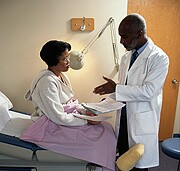
MONDAY, June 30, 2014 (HealthDay News) — The annual pelvic exam has long been a routine part of women’s health care, but new guidelines say there’s no good reason for it.
The recommendations, laid out by the American College of Physicians (ACP), advise against pelvic exams for women who aren’t pregnant and have no symptoms of a potential problem.
The reason? There’s no good evidence the screening exams benefit women, the ACP said.
“I think a lot of women will be relieved by this [recommendation], especially since it’s based on scientific evidence,” said Dr. Linda Humphrey, a member of the ACP’s Clinical Practice Guidelines Committee, which devised the new advice after reviewing 32 studies on the benefits and harms of routine pelvic exams.
Humphrey stressed that the new guidelines apply only to pelvic exams, and that women should continue to have cervical cancer screenings.
For decades, American women have routinely had a yearly pelvic exam. The aim, doctors have said, is to spot cancers of the pelvic organs, infections, and abnormalities such as ovarian cysts or uterine fibroids.
But the ACP team found that no studies have actually tested the accuracy of pelvic exams in screening for most of those conditions.
The researchers did find three studies focused on screening for ovarian cancer in average-risk women. And there was no evidence of a benefit. One study did, however, find that 1.5 percent of women screened ended up having unnecessary surgery.
A larger number of studies tried to weed out the potential harms of routine pelvic exams.
Across eight surveys, anywhere from 11 percent to 60 percent of women called pelvic exams painful or uncomfortable. And in seven studies, 10 percent to 80 percent of women cited fear, anxiety or embarrassment.
One concern, Humphrey said, is that some women will skip their annual “well-woman” visit altogether, just to avoid the pelvic exam.
So how did pelvic exams become so routine in the absence of evidence? “In medicine, a lot of things have been done because we think they might help,” Humphrey said.
“The reasoning behind why clinicians are doing it has never been very clear,” said Dr. George Sawaya, a professor of obstetrics, gynecology and reproductive sciences at the University of California, San Francisco.
Instead, the pelvic exam is more like a “ritual” than an evidence-based practice, said Sawaya, who cowrote an editorial published with the new guidelines in the July 1 issue of the Annals of Internal Medicine.
The reason women have the exam yearly is because it has been traditionally coupled with Pap testing for cervical cancer, Sawaya noted. However, experts no longer recommend annual Pap tests, and instead say women at average risk of cervical cancer can have them every three years, starting at age 21.
Humphrey added that if women want to be screened for a sexually transmitted disease, like gonorrhea or chlamydia, that can be done with a urine test or vaginal swab instead of a pelvic exam.
The ACP represents U.S. internists, but many women get their pelvic exams from gynecologists — who have their own professional guidelines, last updated in 2012.
Those guidelines, from the American College of Obstetricians and Gynecologists (ACOG), are much less direct: On one hand, ACOG says all women age 21 and older should have an annual pelvic exam. But the guidelines go on to acknowledge that “no evidence supports or refutes” the annual screening exam — and that the decision is ultimately up to women and their doctors.
A spokesperson for ACOG said the group did not want to make a “blanket statement” against an exam that might benefit “a lot of women.” And in a written statement, ACOG said its guidelines “complement” the new ones from the ACP.
According to Sawaya, the ACP research review does leave questions open. For one, none of the studies looked at the accuracy of pelvic exams in screening for noncancerous growths.
So, Sawaya writes in the editorial, it’s “reasonable” to disagree with the ACP’s advice.
But he said it’s also reasonable for women to ask their doctor whether a routine pelvic exam is necessary, and to ask for more information on the possible benefits and risks.
If the annual pelvic exam was retired, that should trim health care costs — though the exact figure is unclear, the ACP says. The exam is not especially pricey (Medicare pays about $38 for one), but if millions of women are getting one each year, the costs add up.
In 2013, the ACP says, the United States spent $2.6 billion in “preventive gynecologic examinations.” About one-third of that went toward unnecessary Pap tests in women younger than 21, while an “indeterminate” percentage went toward other unnecessary pelvic exams, according to the ACP.
More information
ACOG has more on women’s annual check-ups.
Copyright © 2025 HealthDay. All rights reserved.

